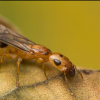I am pretty sure I caught her in Quebec but isn't it too early in the season for them to have nuptials?
she is about 6-7 mm
(I also saw a male and others like her)

I am pretty sure I caught her in Quebec but isn't it too early in the season for them to have nuptials?
she is about 6-7 mm
(I also saw a male and others like her)
Currently keeping:
1x Formica subsericea, 35-40 workers + maybe eggs *New* 2x Camponotus nova, one has only larva
1x Crematogaster cerasi, All workers is ded ![]() *extreme internal screaming* 1x Myrmica ruba sp around 10 workers + pupa
*extreme internal screaming* 1x Myrmica ruba sp around 10 workers + pupa
*New* 1x Temnothorax curvispinosus, 101 or something worker + 3 or 4 royal mom ants + pile of white ant worms
*As you watch your ants march, remember that every thing begins with a small step and continued by diligence and shared dreams* -A.T (which is Me)
Sadly due to unforeseen consequences, I will soon be giving away my colonies (I will miss them though ![]() )
)
Myrmica Rubra. I have a bunch. Semi-claustral so will require feeding during the founding stage. She also sometimes overwinters with her eggs, before having full adult workers, so it may take a while to get this colony started! Hope it works!
Manica invidia (1 queen, ~200 workers)
Manica invidia (1 colonies, 1 queens plus 3 workers)
Lasius niger (single queen, ~200 workers - naturalistic, predatory set-up)
Lasius americanus (1 colony, ~10 workers)
Tetramorium immigrans (3 colonies, 3 queens, ~ five workers each | 1 colony, 1 queen, ~1200 workers)
Formica aserva (aserva queen, ~15 Formica neorufibarbis workers)
"And God made...everything that creeps on the ground according to its kind.
And God saw that it was good." - Genesis 1:25
but I am pretty sure they have like one of the last nubtial flights of the season where I am ![]()
Currently keeping:
1x Formica subsericea, 35-40 workers + maybe eggs *New* 2x Camponotus nova, one has only larva
1x Crematogaster cerasi, All workers is ded ![]() *extreme internal screaming* 1x Myrmica ruba sp around 10 workers + pupa
*extreme internal screaming* 1x Myrmica ruba sp around 10 workers + pupa
*New* 1x Temnothorax curvispinosus, 101 or something worker + 3 or 4 royal mom ants + pile of white ant worms
*As you watch your ants march, remember that every thing begins with a small step and continued by diligence and shared dreams* -A.T (which is Me)
Sadly due to unforeseen consequences, I will soon be giving away my colonies (I will miss them though ![]() )
)
I am now looking at her and she is a bit wobbly on her feet and her antenna has stopped moving
Currently keeping:
1x Formica subsericea, 35-40 workers + maybe eggs *New* 2x Camponotus nova, one has only larva
1x Crematogaster cerasi, All workers is ded ![]() *extreme internal screaming* 1x Myrmica ruba sp around 10 workers + pupa
*extreme internal screaming* 1x Myrmica ruba sp around 10 workers + pupa
*New* 1x Temnothorax curvispinosus, 101 or something worker + 3 or 4 royal mom ants + pile of white ant worms
*As you watch your ants march, remember that every thing begins with a small step and continued by diligence and shared dreams* -A.T (which is Me)
Sadly due to unforeseen consequences, I will soon be giving away my colonies (I will miss them though ![]() )
)
Myrmica, yes, but not identifiable to species from this photo. To confirm M. rubra we would need a view of the face showing the evenly curved base of the scape, lacking any sort of lobe or carina, and the straight to slightly convex frontal carinae.
but I am pretty sure they have like one of the last nuptial flights of the season where I am
Yah what I mean is that although they fly in August (at least where I live) they'll overwinter in their parents' colony, and leave in the spring, to begin their own colony. This according to Antwiki, anyways. This is actually how I caught my myrmica rubra!
I am pretty sure I caught her in Quebec but isn't it too early in the season for them to have nuptials?
she is about 6-7 mm
(I also saw a male and others like her)
Also I hope this is a macrogyne, not a microgyne, which are semi-parasitic and lay eggs alongside macrogynes. I don't think they can lay by themselves.
Manica invidia (1 queen, ~200 workers)
Manica invidia (1 colonies, 1 queens plus 3 workers)
Lasius niger (single queen, ~200 workers - naturalistic, predatory set-up)
Lasius americanus (1 colony, ~10 workers)
Tetramorium immigrans (3 colonies, 3 queens, ~ five workers each | 1 colony, 1 queen, ~1200 workers)
Formica aserva (aserva queen, ~15 Formica neorufibarbis workers)
"And God made...everything that creeps on the ground according to its kind.
And God saw that it was good." - Genesis 1:25
she is a macrogene
I was unsure about her size but I learnt that microgene are smaller tho ![]()
Currently keeping:
1x Formica subsericea, 35-40 workers + maybe eggs *New* 2x Camponotus nova, one has only larva
1x Crematogaster cerasi, All workers is ded ![]() *extreme internal screaming* 1x Myrmica ruba sp around 10 workers + pupa
*extreme internal screaming* 1x Myrmica ruba sp around 10 workers + pupa
*New* 1x Temnothorax curvispinosus, 101 or something worker + 3 or 4 royal mom ants + pile of white ant worms
*As you watch your ants march, remember that every thing begins with a small step and continued by diligence and shared dreams* -A.T (which is Me)
Sadly due to unforeseen consequences, I will soon be giving away my colonies (I will miss them though ![]() )
)
0 members, 1 guests, 0 anonymous users